The African American Experience
Milestones
The following sequence of images depicts a selection of leading individuals who were instrumental in the advancement of African American representation within the Parks Department.
Click a thumbnail to view an image. Once a larger image appears, click it to advance to the next photo.
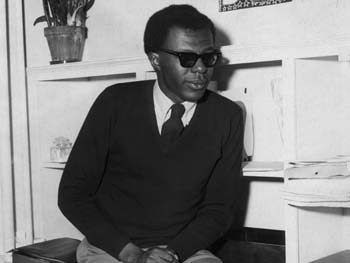
Courtney Callender, the Arsenal, Central Park, November 1966
New York City Parks Photo Archive, Neg. 32685–2Courtney Callender (1937–1983) was appointed by Commissioner Thomas Hoving in 1966 to serve as the head of the Park's Department's first office of Community Relations, and was the agency's first high–ranking African American official.
The creation of this office marked the City's realization and acknowledgement that it should be more responsive to the public's needs in designing and programming its parks. Callender was a graduate of Stuyvesant High School and Howard University, and assumed this important post at age 29.
In 1969 he was promoted by Commissioner August Hecksher to Deputy Commissioner of Cultural Affairs, a post he held until 1972 and which he used to establish the Harlem Cultural Festival.
Later he served as director of the Studio Museum of Harlem and head of educational programming for WNET television. He died of cancer at age 46, and a playground in Harlem was named for him in 1984.
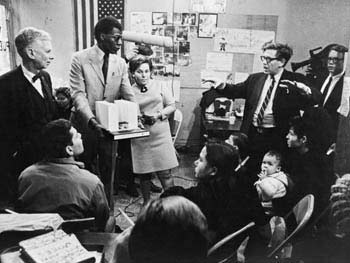
Commissioner Hecksher, Courtney Callender, and Alfred Shapiro at Community Presentation, Lower East Side, 1967
Katrina Thomas/New York City Parks Photo ArchiveAt this meeting at a Lower East Side Puerto Rican community center, Courtney Callender (1937–1983), the Parks Department's first director of Community Relations, holds a model for a vest pocket park, as Alfred Shapiro (at right) explains plans, and Parks Commissioner August Heckscher (far left) looks on.
Callender was later promoted to Deputy Commissioner of Cultural Affairs, and also served as director of the Studio Museum of Harlem and WNET's educational programming. A playground in Harlem is named in his honor.
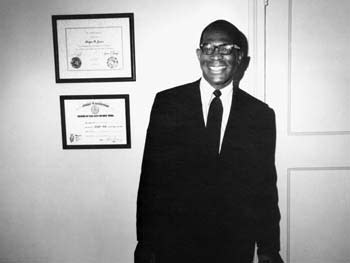
Hayes Joynes, Arsenal, Central Park, June 6, 1968
New York City Parks Photo ArchiveShortly before Mayor Lindsay established the Recreation and Cultural Affairs Administration, he appointed Hayes Jones the first Commissioner of Recreation. Joynes, who was 29 years old at the time, had won the gold medal in the 110–meter high hurdles at the Tokyo Olympics in 1964 (he won a bronze at the Rome Olympics of 1960).
Lindsay commented that Jones was “superbly qualified to launch the city's recreation program” and that he was an “inspirational leader”. Jones served as recreation commissioner until 1970.
He later served as a representative from Pontiac, Michigan in the United States Congress, and is today the general manager in the Suburban Mobility Authority for Regional Transportation in Michigan.
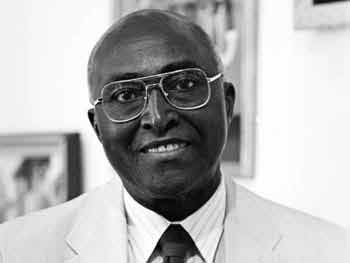
Pelham Fritz, Arsenal, Central Park, August 20, 1986
New York City Parks Photo Archive, Neg. 60026Born in Trinidad, Pelham Fritz (1920–1988) moved to Harlem at age seven and frequented Mount Morris (now Marcus Garvey) Park. Fritz, who eventually rose to the rank of assistant commissioner of recreation at the Parks Department, began his recreation career at a City juvenile detention center.
Known for his gentle optimism and his strong leadership, Fritz gained his first job with Parks as an athletic coach at the Hamilton Houses Playground, and he was one of the original organizers of the celebrated Holcombe Rucker Community Basketball League.
In addition to his Parks career, Fritz was active in the Harlem YMCA, the Abyssinian Baptist Church, and the Children's Aid Society, and received 102 plaques or citations during his life for community service.
The recreation center in Marcus Garvey Park was named for him shortly after his death in 1988, and a housing facility at 21 West 118th Street also bears his name.
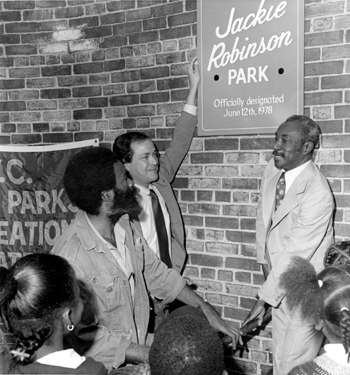
Gordon Davis at Jackie Robinson Park Dedication, June 12, 1978
New York City Parks Photo Archive, Neg. 53137.10In 1978 Colonial Park was officially renamed for Jackie Robinson (1919–1972), who notably broke the “color barrier” in professional baseball when he was played for the Brooklyn Dodgers on April 15, 1947. The first African American to play in a Major League baseball game, Robinson paved the way for generations of black athletes competing in American's “national pastime.”
Robinson helped lead the Dodgers to six World Series appearances, and was inducted into the Baseball Hall of Fame in 1962. After retiring from baseball, he became a businessman at the Chock–Full–of–Nuts restaurant chain, and was involved in several black–owned community–based enterprises, such as the Freedom National Bank, which he co–founded. He was also active in the National Association for the Advancement of Colored People (NAACP) and later served as special advisor to New York State Governor Nelson A. Rockefeller.
In this picture Gordon J. Davis, the first African American to hold the post of Parks Commissioner, and Councilman Fred Samuel unveil the sign renaming the park for Robinson. Appointed by Mayor Edward I. Koch, Davis served as commissioner from 1978 to 1983. As Commissioner, Davis helped revitalize the Parks Department, establishing the Central Park Conservancy and Urban Park Rangers, among many reforms and improvements enacted during his administration.
A partner in the law firm of Dewey & LeBoeuf LLP in 2009, Davis has served as a trustee or board member of numerous institutions, including Con Edison, the Studio Museum of Harlem, the New York Public Library and the Phoenix Companies, and has served as chairman of Jazz at Lincoln Center.
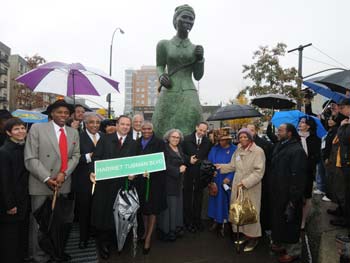
Harriet Tubman Sculpture Dedication, Tubman Triangle, November 13, 2008
Malcolm Pinckney/New York City Parks Photo ArchivePublic officials, Tubman descendants, and members of the community celebrate the dedication of Swing Low, the memorial to Harriet Tubman by African American artist Alison Saar.
Born into slavery, Tubman escaped in 1849, and later helped scores of family and friends to freedom on the “Underground Railroad.” The memorial was commissioned through the Department of Cultural Affairs' Percent for Art Program with an allocation of funding from former Manhattan Borough President C. Virginia Fields.
Saar depicts Tubman in a heroically–sized bronze intended to show her “not as the conductor of the Underground Railroad but as the train itself, an unstoppable locomotive,” with the roots of slavery pulled up in her wake.
The sculpture stands in a landscaped triangle at the crossroads of St. Nicholas Avenue, West 122nd Street, and Frederick Douglass Boulevard in Harlem.
Douglass once said of Tubman that except for John Brown, he knew of “no one who has willingly encountered more perils and hardships to serve our enslaved people.”
Present at this event were Pauline Copes Johnson and her sister Geraldine Daniels, great grand nieces of Tubman, as well as their cousin Adrianne Jones–Roderick.
Among those posing in this photo are State Senator Bill Perkins, Congressman Charles Rangel, Parks Commissioner Adrian Benepe, Christopher Moore of the Schomberg Center, former Manhattan Borough President C. Virginia Fields, artist Allison Saar, Commissioner David Burney of the Department of Design and Construction, several descendents of Harriet Tubman, and Commissioner Kate Levin of the Department of Cultural Affairs.
Related Links
- Black History in NYC Parks
- Sculptures Honoring the African–American Experience
- African–American Namesake Parks